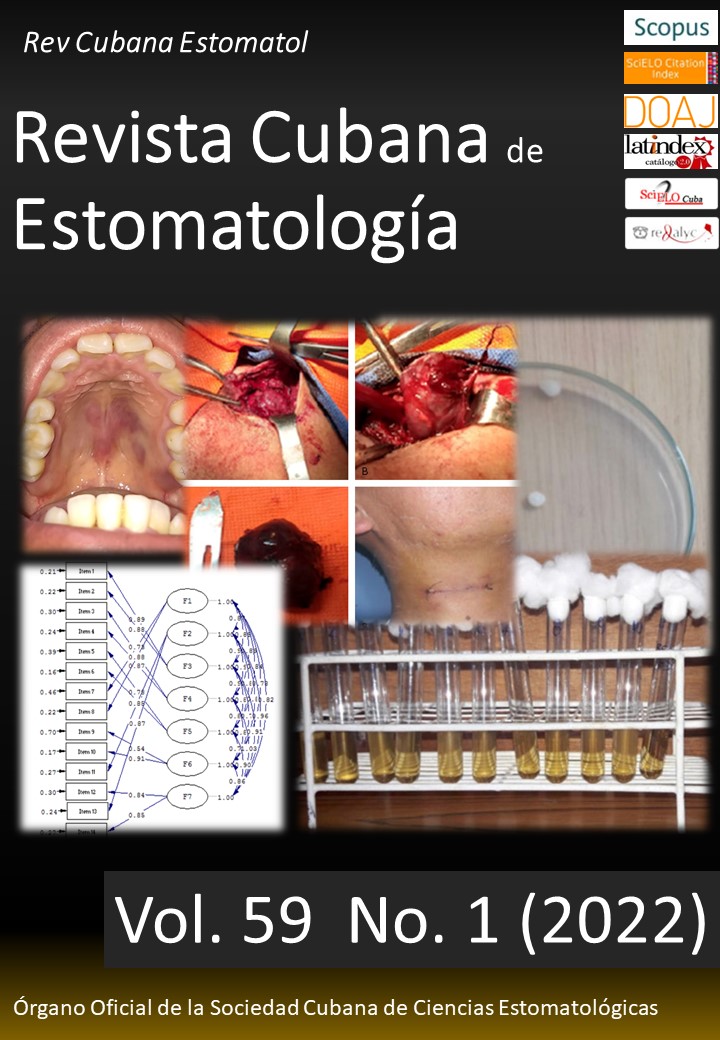Flexural properties and color stability of indirect esthetic restorative materials
Keywords:
composite resins, ceramic, color perception.Abstract
Introduction: Differences in the mechanical properties of ceramic and resin-based materials pose the question of which of the two will perform better in the long run.
Objectives: Evaluate the flexural resistance and color stability of different indirect esthetic restorative materials.
Methods: The materials selected were Filtek™ Z250 XT (3M ESPE), Ceramage (SHOFU Dental), VITA VM® LC and VITA ENAMIC® (VITA Zahnfabrik), IPS e.max® (Ivoclar-Vivadent) and Zolid FX (Amann Girrbach AG). The flexural resistance assay (n = 10) was conducted in a universal mechanical testing machine. Color readings (n = 5) were taken with a VITA Easyshade V® spectrophotometer.
Results: All-ceramic materials had better mechanical performance (p < 0.001). Color stability results show that Ceramage, IPS e.max® and Zolid FX displayed a statistically significant difference (p ≤ 0.002) with respect to Filtek Z250 XT, VITA VM® LC and VITA ENAMIC®.
Conclusions: All-ceramic materials exhibited greater flexural resistance and color stability than polymer-based materials. However, indirect esthetic materials with polymers in their composition, such as Ceramage, are presented as a valid alternative, due to their appropriate mechanical properties and their color stability, which is similar to that of ceramic materials.Downloads
References
Smithson J, Newsome P, Reaney D, Owen S. Direct or indirect restorations? Int Dent. 2011;1(1):70–80.
Pjetursson BE, Valente NA, Strasding M, Zwahlen M, Liu S, Sailer I. A systematic review of the survival and complication rates of zirconia‐ceramic and metal‐ceramic single crowns. Clin Oral Implants Res. 2018 Oct 17;29(S16):199–214.
Belli R, Geinzer E, Muschweck A, Petschelt A, Lohbauer U. Mechanical fatigue degradation of ceramics versus resin composites for dental restorations. Dent Mater. 2014 Apr;30(4):424–32.
Demarco FF, Collares K, Correa MB, Cenci MS, Morales RR de, Opdam NJ. Should my composite restorations last forever? Why are they failing? Braz Oral Res. 2017 Aug 28;31(suppl 1).
Edelhoff D, Özcan M. To what extent does the longevity of fixed dental prostheses depend on the function of the cement? Working Group 4 materials: cementation. Clin Oral Implants Res. 2007 Jun;18:193–204.
Fron Chabouis H, Smail Faugeron V, Attal J-P. Clinical efficacy of composite versus ceramic inlays and onlays: A systematic review. Dent Mater. 2013 Dec;29(12):1209–18.
Saba DA, Salama RA, Haridy R. Effect of different beverages on the color stability and microhardness of CAD/CAM hybrid versus feldspathic ceramic blocks: An in-vitro study. Futur Dent J. 2017 Dec;3(2):61–6.
Morimoto S, Rebello de Sampaio FBW, Braga MM, Sesma N, Özcan M. Survival Rate of Resin and Ceramic Inlays, Onlays, and Overlays. J Dent Res. 2016 Aug 20;95(9):985–94.
International Organization for Standarization. ISO 4049:2009 Dentistry Polymer based restorative materials. 2009.
Yap A, Eweis A, Yahya N. Dynamic and Static Flexural Appraisal of Resin-based Composites: Comparison of the ISO and Mini-flexural Tests. Oper Dent. 2018 Sep 1;43(5):E223–31.
Grazioli G, Francia A, Cuevas-Suárez CE, Zanchi CH, Moraes RR De. Simple and Low-Cost Thermal Treatments on Direct Resin Composites for Indirect Use. Braz Dent J. 2019 Jun;30(3):279–84.
Sharma G, Wu W, Dalal EN. The CIEDE2000 color-difference formula: Implementation notes, supplementary test data, and mathematical observations. Color Res Appl. 2005 Feb;30(1):21–30.
Paravina RD, Ghinea R, Herrera LJ, Bona AD, Igiel C, Linninger M, et al. Color Difference Thresholds in Dentistry. J Esthet Restor Dent. 2015 Mar;27:S1–9.
International Organization for Standarization. ISO 6872:2015 Dentistry - ceramic materials. International Organization for Standadization. 2015.
Tavares L do N, Zancopé K, Silva ACA, Raposo LHA, Soares CJ, Neves FD das. Microstructural and mechanical analysis of two CAD-CAM lithium disilicate glass-reinforced ceramics. Braz Oral Res. 2020;34.
Bociong K, Szczesio A, Krasowski M, Sokolowski J. The influence of filler amount on selected properties of new experimental resin dental composite. Open Chem. 2018 Sep 18;16(1):905–11.
Cuevas-Suárez CE, Meereis CTW, D’accorso N, Macchi R, Ancona-Meza AL, Zamarripa-Calderón E. Effect of radiant exposure and UV accelerated aging on physico-chemical and mechanical properties of composite resins. J Appl Oral Sci. 2019;27.
Acar O, Yilmaz B, Altintas SH, Chandrasekaran I, Johnston WM. Color stainability of CAD/CAM and nanocomposite resin materials. J Prosthet Dent. 2016 Jan;115(1):71–5.
Poggio C, Ceci M, Beltrami R, Mirando M, Wassim J, Colombo M. Color stability of esthetic restorative materials: a spectrophotometric analysis. Acta Biomater Odontol Scand. 2016 Dec 19;2(1):95–101.
Heintze SD, Ilie N, Hickel R, Reis A, Loguercio A, Rousson V. Laboratory mechanical parameters of composite resins and their relation to fractures and wear in clinical trials—A systematic review. Dent Mater. 2017 Mar;33(3):e101–14.
Published
How to Cite
Issue
Section
License
Authors retain all rights to their works, which they can reproduce and distribute as long as they cite the primary source of publication.
The Rev Cubana Estomatol is subject to the Creative Commons Attribution-Non-Commercial 4.0 International License (CC BY-NC 4.0) and follows the publication model of SciELO Publishing Schema (SciELO PS) for publication in XML format.
You are free to:
- Share — copy and redistribute the material in any medium or format.
- Adapt — remix, transform, and build upon the material.
The licensor cannot revoke these freedoms as long as you follow the license terms.
Under the following terms:
Attribution — You must give appropriate credit, provide a link to the license, and indicate if changes were made. You may do so in any reasonable manner, but not in any way that suggests the licensor endorses you or your use.
- NonCommercial — You may not use the material for commercial purposes.
No additional restrictions — You may not apply legal terms or technological measures that legally restrict others from doing anything the license permits.
Notices:
- You do not have to comply with the license for elements of the material in the public domain or where your use is permitted by an applicable exception or limitation.
- No warranties are given. The license may not give you all of the permissions necessary for your intended use. For example, other rights such as publicity, privacy, or moral rights may limit how you use the material.


